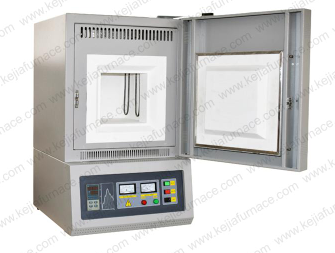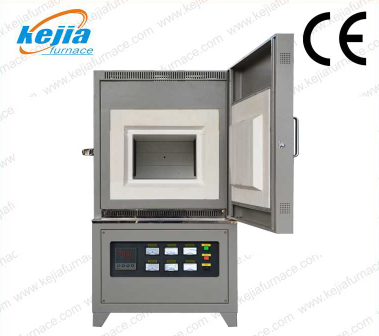When selecting an experimental box type high-temperature furnace (CVD related heat treatment scenario), a comprehensive evaluation should be made from seven core dimensions: temperature range, furnace size, heating performance, furnace body material, control system, safety design, energy consumption, and maintenance, and decisions should be made based on experimental requirements and budget. Let’s take a detailed look below!

A commonly used small 1700 ℃ experimental box furnace (click on the image to view product details)
1. Clarify experimental requirements: the basis for selection
temperature range
The temperature requirements vary greatly among different materials and processes. For example:
Metal quenching: Steel requires 800 ℃ -1000 ℃, aluminum alloy requires 400 ℃ -600 ℃;
Ceramic sintering: requires 1200 ℃ -1600 ℃;
Semiconductor materials: may require high temperatures above 1800 ℃.
Selection principle: The maximum temperature of the equipment should cover the process requirements, but there is no need to blindly pursue excessively high temperatures to avoid increasing costs and energy consumption.
Furnace size
Select based on sample size and quantity:
Small size furnace (such as 6L-20L): suitable for laboratory small batch sample processing;
Large furnace size (such as 30L or more): suitable for industrial scale large-scale production.
Key point: Ensure that there is a space for hot air circulation after placing the sample to avoid uneven temperature.
Heating rate and temperature uniformity
Heating rate: Rapid heating (such as reaching 1000 ℃ in 30 minutes) is suitable for time sensitive processes;
Temperature uniformity: Precision material processing requires a uniform temperature field (such as ± 5 ℃), and attention should be paid to the design of the furnace’s thermal field and the layout of heating elements.
2. Core performance parameters: key to selection
Heating element material
Resistance wire: suitable for medium and low temperature furnaces (such as ≤ 1000 ℃), with a short lifespan;
Silicon carbon rod: Moderate price, but requires inert atmosphere or protective gas;
Silicon molybdenum rod: resistant to temperatures below 1800 ℃, with better resistance to high temperatures and oxidation, suitable for high-temperature furnaces.
Selection suggestion: Choose according to the highest temperature requirement, and prioritize silicon molybdenum rods for high temperature scenarios.
Furnace material
Refractory bricks: traditional materials with low cost but average insulation effect;
Aluminum oxide fiber/silicon carbide: commonly used in high-end equipment, with better insulation performance and reduced heat consumption.
Selection suggestion: When pursuing energy conservation and efficiency, choose alumina fiber furnace.
Temperature controller
Controller type: Digital PID controller is superior to traditional analog controller and supports multi-stage heating curve setting;
Sensor accuracy: Platinum rhodium thermocouples are suitable for high-temperature furnaces and have good stability;
Sensor location: Try to be as close to the workpiece area as possible to avoid measurement distortion.
Selection suggestion: Priority should be given to intelligent instruments that support programming control, such as 30 segment PID intelligent temperature control.
3. Safety and Operational Design: Ensuring Experimentation
Security protection mechanism
Overtemperature alarm: Automatic power-off when the temperature exceeds the set value;
Leakage protection: prevent the risk of electric shock;
Furnace door interlock: automatically cuts off power when opening the door to prevent thermal shock.
Selection suggestion: Choose equipment with multiple safety protections, such as over temperature, leakage, and overload protection.
Convenience of operation
Furnace door design: Side opening door design for easy access to samples;
Control interface: touch screen or numeric keypad operation, supports remote monitoring (high-end models);
Exhaust system: equipped with an adjustable chimney to facilitate exhaust emissions.
Selection suggestion: Choose equipment with a user-friendly interface based on the frequency of experiments to improve efficiency.
4. Energy consumption and maintenance costs: considerations for long-term use
Energy consumption optimization
Insulation material: Ceramic fiber furnace saves more than 30% energy compared to traditional refractory bricks;
Power matching: Select the power according to the process requirements to avoid “big horses pulling small cars”.
Selection suggestion: Prioritize energy-saving equipment for lower long-term operating costs.
Maintain convenience
Heating element lifespan: The lifespan of silicon molybdenum rods can reach over 2000 hours, while the lifespan of resistance wires is only about 500 hours;
Furnace replacement frequency: The lifespan of alumina fiber furnace is 3-5 times that of refractory bricks;
Spare parts supply: Select suppliers to provide fast spare parts response services.
Selection suggestion: Pay attention to the heating element and furnace material to reduce the risk of shutdown.
5. Typical application scenarios and model recommendations
Laboratory small-scale processing
Recommended model: 6L-20L box furnace (6L, 1000 ℃);
Features: Small size, fast heating, energy-saving (energy consumption is 1/3 of traditional furnaces).
Industrial grade mass production
Recommended model: 30L or above box furnace (30L, 1400 ℃);
Features: Large furnace, high power, supports three-phase power supply.
High temperature precision processing
Recommended model: Silicon molybdenum rod heating furnace, such as 1700 ℃ high-temperature box furnace;
Features: High temperature resistance, uniform temperature field (± 1 ℃), support for multi-stage programming control.

Large capacity 1700 ℃ high-temperature experimental box furnace (click on the picture to view product details)
In general, when choosing a box type high-temperature furnace, you can refer to the above points. It is recommended to communicate with relevant technical personnel before purchasing, so that you can customize a box type high-temperature furnace that is more suitable for your needs!Click to learn more muffle furnaces! Or click on online customer service to learn more about product information!